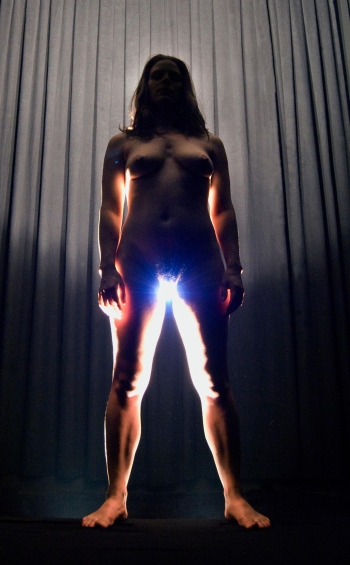It begins with an A4 sheet of paper on the seats: a quote from Carolee Schneemann about ‚Interior Scroll‘. I am ecstatic, I know this only too well from uni. The white curtain opens, a copper die moves as if by magic, the sound bite from Schneeman plays. She talks of vulvic energy and the necessity to embody images in order for their power to unfold. Curtain.
Upon opening again, we see Anne Juren, a simple dress, Madonna-blue. A little magic in the ‘kitchen’, water appears and disappears, she plays with the ideas of presence and absence, the female void. Eggs feature, a bra is conjured. Laughter from the audience. A naked breast. So far, so easily palatable. Juren lures her audience, nothing goes too far, nothing is too heavy or too explicitly feminist in this opening number of the variété that is ‘Magical’.
Once locked in the relationship of reciprocal acknowledgement – without audience participation, a stroke of genius! – the curtain closes, polite, joyful applause. Open curtain. Juren sits on the floor, demurely, a big pair of scissors in front of her. She looks calmly, confidently, centred. No evasion possible. This beautiful woman, barefoot projects an active presence that is remarkable without any trace of artificiality. She picks up the scissors, slowly, and cuts a small piece out of her dress, above her right breast. Puts down the scissors. Picks them up again. Cuts away the fabric from the abdomen. Down go the scissors. Up again. The front falls open. The more exposed she gets, the more the lights rise, enough for the first few rows to become partially visible. No one can hide from the intense acuteness of Juren’s body. Her eyes never once stray to look where she is cutting, she regards the audience as they regard her. Astonishing subversion of the often talked about ‘male gaze’. The first spectator leaves, too much the tension of this unashamed exposure which happens entirely on Juren’s terms. She pauses once the dress is discarded. A leopard bra and orange lace knickers. The mismatch is only too human, too true, so utterly unstaged. It is impossible not to see Juren as herself, and as a person. Slowly, she cuts away the bra, then the underpants. Her pubic hair looks soft and surprisingly unoffensive. The next spectator leaves. She stands up, a beautiful woman, who seems powerful in her vulnerability, which to me – bizarrely - derives mainly from the fact that she is not wearing shoes. Annie Dorsen appears, in the nude, picks up the smaller pieces of fabric as Juren wraps the remains of the blue dress around her head. The curtain closes behind the blindfolded woman as rhythmic music begins. The next section causes several people – all women! – to leave, although for a good five minutes, nothing much happens: Juren sways to the rhythms, wriggles, bounces, her body visceral to a degree that seems to create a meta-reality. The music pulses, voices appear and disappear, a woman’s voice seems to approach climax but fades out before it is reached. It seems an eternity in which one may simply regard the beauty of this real, uncostumed body or despair at its inert presence that cannot be denied or abstracted; then Juren braks into dance, the robot, disco dance, the music booms “I want to give you every inch of my loving” (a woman) and “shake it baby… I want to give you my name” (a man), and she taunts and flaunts and subverts all the conventions of the presentation of female bodies in contemporary popular culture. Standing ovations after she strides off the stage. Black out.

The next section begins with a projection of Schneemann’s ‘Meat Joy’ from behind onto the white curtain. What follows is a combination of magic tricks and the subversion of pornographic and classical art poses. Juren seemingly removes coloured fabric from her hand, ear, nose and finally a long scarf from her vagina. Stunned silence unifies the men, understanding chuckles the women of the audience. Other objects include batteries and a string of fairy lights that stop glowing as soon as the connection to Juren’s body is cut off. The curtain closes for a moment, the projection reappears, the curtain opens. The light is projected from between the performer's legs. What is usually the focus of pornographic films is now the origin of erotic film material. My male companion later states he felt “looked at in a peculiar way…because that usually never happens”. The actress illuminates the walls, ceiling, audience with this source of light, this origin of all action at the moment in the piece. The curtain closes. Another spectator leaves.

Lights come up again, the curtain opens, a simple reference to ‘Action Pants: The Genital Panic’ from 1969, the curtain closes, opens again, the machine gun has turned to fairy dust, the curtain closes again, opens, Juren and Dorsen bow to standing ovations. Six times do they have to reappear.
In the beginning I wasn’t sure whether I would be comfortable with feminist explicit body performance, nudity on stage that is not projected onto a dramatic ‘character’. Also, I was not sure how my male friend would react since I had booked the tickets without him knowing what was in store. “I have never in my life had the feeling to have understood a theatre performance so entirely,” he muses as we walk through nocturnal Salzburg. I am exultant, rejoicing in the knowledge that I have witnessed something profound without it ever resorting to shock tactics or petulant anger.
